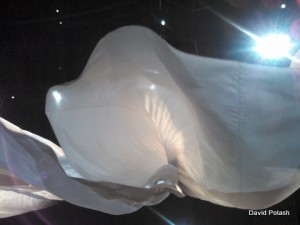Ann Hamilton – Hanging By A Chain
 Since 2006 the Park Avenue Armory in NYC has been a mecca for performances and site-specific art installations. It is a difficult commission, for the building has a history and scale that competes for attention and can easily overwhelm.
Since 2006 the Park Avenue Armory in NYC has been a mecca for performances and site-specific art installations. It is a difficult commission, for the building has a history and scale that competes for attention and can easily overwhelm.
Ann Hamilton’s Event of a Thread at the Armory was a complex “multisensory affair” featuring 42 swings connected to a large flowing curtain bisecting the Drill Hall, and a conglomeration of creative ephemera: caged pigeons, newspaper-wrapped radios, a daily song captured in vinyl (which was played back the following day), and some somber looking functionaries, dressed like extras in a Margaret Atwood dystopia, focused on various tasks with great seriousness.
Hamilton very cleverly coupled the swings, each of which could seat two comfortably, in the ceiling. This dampened their arcs and made for some  very interesting patterns in the curtain, which moved in relationship to the swings. Part steam punk, part Stevie Nix, the exhibit was both an invitation to play and a challenge to experience. What do you look at? And what do you take seriously?
very interesting patterns in the curtain, which moved in relationship to the swings. Part steam punk, part Stevie Nix, the exhibit was both an invitation to play and a challenge to experience. What do you look at? And what do you take seriously?
New York State built many armories after the Civil War when wide-scale street violence was a near memory. Armories were military training grounds, repositories of weapons, club houses for militia, and visible reminders of the power of the National Guard to maintain domestic tranquility. The wealth of the NYC’s upper East Side insured that the Park Avenue Armory was much more than a very large military shed. Some of the period’s most successful designers contributed to the Armory’s lush and elegant social spaces. Its drill hall is enormous with 55,000 square feet unobstructed space. As a point of contrast, Tate Modern’s famous Turbine Hall in London is significantly smaller at only 36,600 square feet. The sheer size of the Drill Hall infantilizes most pieces. It is indifferent to the largest of objects.
The swings in Hamilton’s exhibit kept me busy for the better part of an hour. The swings, playful and childlike, belonged. There was not question about their purpose or integrity. As for the extras, pigeons and the prose, I have not a clue. The complexity of the work rendered it inaccessible. The disparate activities may be related by some common reference, a shared thread of meaning. Or they may not.
Sustained engagement is a necessary but not necessarily sufficient criteria for art to succeed. Hamilton’s simple was far more effective holding attention than her complex. Isn’t it interesting how often that turns out to be true?